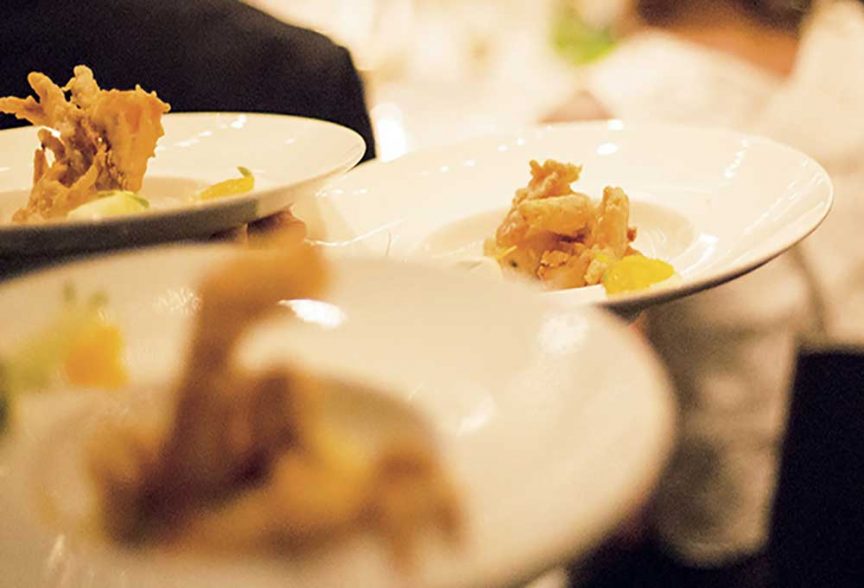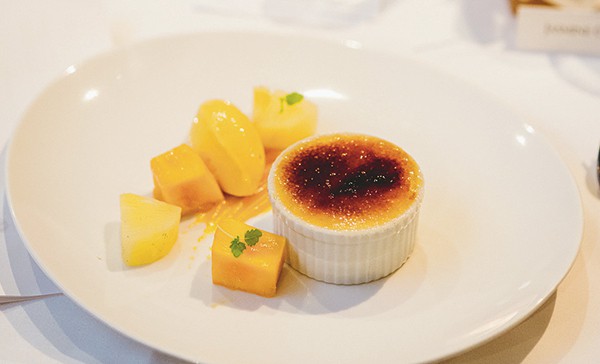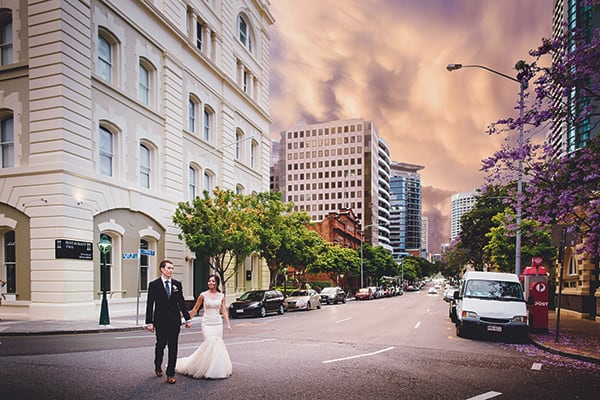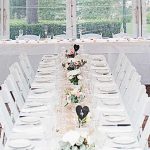Do you want the low-down on all the different menu styles you can do for your wedding? We get the low down from chef David Pugh of Restaurant Two.
For many soon-to-be-weds, selecting a venue and caterer is the biggest decision – not to mention financial cost – of their entire wedding, so it’s important to get it right.When selecting a venue, the food is obviously going to be of paramount importance – after all, that’s what you’re paying for.With the myriad different options for menu styles, it can also be hard to decide which option is right for you and your partner.To help you decide, we asked chef David Pugh from Good Food Guide-hatted RestaurantTwo to explain the benefits and drawbacks of each option.
Related articles: Perfect place: Mercure Clear Mountain Lodge and Breaking down your wedding guests’ dietary requirements
ALTERNATE DROP
The alternate drop option is a mainstay for most wedding venues as it allows them to quickly and easily prepare meals without needing to wait for orders, and also ensures there’s no wastage.This should translate into a lower cost for you as the bride and groom. The downside of course is that not every guest will be happy with what they’re given, and many will want to argue about it, which can put a dampner on the whole evening!
PRE-ORDER
This pre-order strikes a balance between alternate drop and reduced à la carte, allowing guests to personally select their meals in advance of the wedding.This is very popular in America, and it combines many of the advantages of alternate drop (low wastage and faster preparation time) with the benefit of giving guests choice.The only downsides are that some guests do change their minds on the night, and that brides will need to be extremely organised to coordinate the dinner orders of all their guests – while simultaneously juggling lots of other tasks.
GRAZING STATIONS/ COCKTAIL STYLE
I’m a big fan of a cocktail-style or grazing station wedding as they allow your guests to mingle, and save you time and stress not having to create a seating plan. Many brides find the seating plan the most difficult part of planning the whole wedding, and just love their guests being able to get around, mix freely and speak to everyone properly. Canapés can be smaller, bite-sized versions of entrées to ensure guests still have a fine- dining experience.To ensure that everyone’s full, a fork dish is highly recommended during some point in the evening.This option is often a little cheaper than sit-down meals, as you can save money on food and possibly table decorations. If you’re planning a modern and elegant affair, a cocktail-style or grazing station reception are wonderful choices.
DEGUSTATION
Degustation is a foodie’s dream – six delectable courses selected by the chef to wow your guests, washed down with matched wines. However, in practice it can be more tricky. Speeches by over-excited dads and surprise presentations from brothers will have to fit in between courses – plus, staff will have to clear plates and top up wine glasses. It also puts guests on a fairly strict schedule and leaves less time for dancing after dinner. I think degustations are ideal for proposals or a long, romantic evening with just you and your beloved, however for weddings, it’s definitely for those couples who don’t care as much about the after-party.
BUFFET
Buffet dinners have long been popular with convention centres and function venues, as each guest is given a choice of what they want. Previously given a bad rap thanks to sloppy salad bars and weird combinations, (cranberry with curried potato salad, anyone?), high-end buffets can be downright delicious when done right.They also eliminate the need to order, which saves time at the start of the night. One downside is high wastage: the venue is forced to overcater, so you’ll need to pay for more than your guests actually consume – which can be very expensive if you’re ordering high-quality, fresh produce like seafood, or meats such as beef and lamb.Your guests may also have to wait substantial amounts of time to line up for meals.There’s also a risk that the more popular dishes will run out, and guests served early invariably take all the good stuff, like the crispy parts of the potato dauphinoise, the crunchiest bread and the best cuts of meat!
REDUCED À LA CARTE
This is my personal favourite.With many couples and their friends now being very food- and wine-focused, a reduced à la carte menu allows you and your guests to order from a menu on the night of your wedding. This ensures that no one is disappointed with what they get because everyone can select their favourite dish. At Restaurant Two, we offer three options per course, as that allows the kitchen to easily prepare each course with no delays, while ensuring everyone’s tastes are catered for.We often have customers comment that even with only three options, it’s so hard to decide! As it’s very unusual for a wedding venue to offer reduced à la carte, we find there’s a real excitement and buzz in the room when guests realise they can actually pick for themselves. The only potential downsides with reduced à la carte are that sometimes it can take a while for guests to decide on a meal and give their orders, however a good waitperson can always help with this by making recommendations.
David Pugh is the chef and owner of RestaurantTwo, 2 Edward Street, Brisbane.
Now you’ve got the menu, time to find the venue! Check out our QB reception guide.











